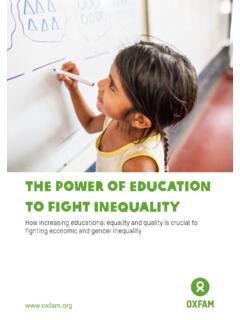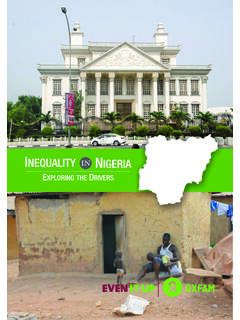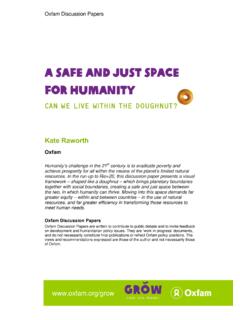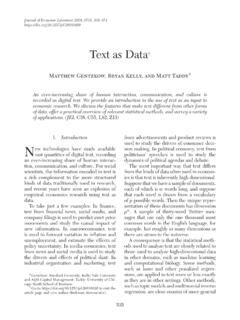Transcription of YOUTH AND INEQUALITY
1 OXFAM BRIEFING PAPER 12 AUGUST 2016 Photo: Ulysse Lemerise/Oxfam-Qu bec. Marche Monde, Montreal 6 May 2016. YOUTH AND INEQUALITY Time to support YOUTH as agents of their own future Young women and men today must grapple with serious social, political and environmental problems inherited from their elders. Yet they are systematically excluded from policy decisions, even though young people make up one quarter of humanity. By marshalling the energy, creativity and talents of YOUTH to address the multiple inequalities they face, we will all reap a demographic dividend and build a fairer world. SUMMARY Inequalities between generations have grown at an alarming rate over the past few decades, paralleling the rise in the gap between rich and poor.
2 The policies that enabled an outrageously large portion of the world s wealth to accrue to the very top of the income spectrum have delivered a difficult present and uncertain future to a huge majority of today's YOUTH . At the same time, young people possess the energy, creativity and passion to take on the intractable problems they have inherited from their elders. Less imprisoned by ideological and institutional strictures, they have demonstrated the ability to think outside the box and develop innovative solutions. The YOUTH population of the world is the largest it has ever been: billion people between the ages of 10 and 24, the majority of whom live in urban areas of developing countries.
3 Given their numbers, YOUTH could offer many of the world s poorest countries a demographic dividend : when today s young people attain working age, they will far outnumber the dependent population. With the right investments and policies aimed at YOUTH , across sub-Saharan Africa that dividend could be as much as one-third of the region s current GDP, for as many as 30 years. Despite their strength in numbers and their creative potential, YOUTH are largely excluded from formal political processes and continue to be subject to age-based systems of authority. Even though they will bear the brunt of the world's unsolved dilemmas, like the effects of climate change, they are marginalized politically and culturally.
4 This sad fact is evident in adult-centric public policies and in social norms and values that usually fail to take into account of young people s views, interests or voices. YOUTH are demanding political representation and a say in government policy. Langgin, for example, a 20-year-old from a farming community in the Philippines island of Mindanao, is one. She spends her energy bringing together young people in her region to talk about the effects of climate change and raise their concerns to local government. She was motivated to take up activism when unexpected extremes in weather caused her family s harvest to fail and she had to abandon her plan to become a veterinarian. Not surprisingly, YOUTH are at the forefront of many of the world s emerging political movements.
5 They have delivered piercing critiques of the extent to which wealth and privilege have rewritten the rules of the system, shifted ever more economic risk to YOUTH and barred YOUTH from a fair say in the policies that affect their lives. Recent years have seen a considerable uptick in interest in YOUTH issues among political leaders and civil society groups. In the last five years there has been an explosion of meetings, summits, forums, and other events aimed at advancing innovative solutions to problems that affect I hope every girl finds the courage to beat the odds and shine through all the hardships and obstacles that society imposes on girls and all people belonging to marginalized communities.
6 Zainab Asif Dar, 22 years old, student, Pakistan 2 YOUTH and building connections among YOUTH from different regions of the world. Similarly, there has been a 50 percent increase in the number of countries that have national YOUTH policies. If today's YOUTH are to become the motor of tomorrow s economic takeoff, policy makers must make concerted efforts to enhance YOUTH participation in policy making. They should engage with young people as active citizens, architects of their own future. They should provide YOUTH with quality education, access to health services and the training and support they need to obtain decent and sustainable employment. And policy makers should look beyond employment and education to address other fundamental inequalities young people face.
7 YOUTH is not a homogenous group, and certain young people are more affected by INEQUALITY than others. Millions of YOUTH around the world face discrimination based on their gender, sexual orientation, race, caste, religion, ethnicity, physical abilities or the place where they live. The intersectional nature of these forms of systemic discrimination experienced by young people deserves special attention. Young people will be instrumental in finding solutions to the challenge of INEQUALITY . Today's YOUTH form the generation that has the best chance to end poverty, stop climate change and ensure the Sustainable Development Goals (SDGs) become a reality. Support and solidarity from their elders can help them gain the power, knowledge, and skills to achieve these goals.
8 Parents, educators, policy makers and other leaders should ally with young people in tackling norms and behaviors that prevent us all from realizing our fundamental rights and building a more tolerant, peaceful and just society. Since 2014 Oxfam has called for urgent action to tackle extreme INEQUALITY , which threatens to undermine the last quarter-century s progress in reducing poverty. INEQUALITY , in its various forms, poses a fundamental challenge to YOUTH well-being today around the world. We hope this paper will contribute to a deeper understanding of the challenge, and to more effective action to address it. As a young Dene woman, I have seen and experienced oppression understand that it will be up to my generation and younger generations to actively see the UN s Sustainable Development Goals through to fruition.
9 It is a big I will try to do my part in my own home communities. Angela Code, 27-year-old Sayisi Dene First Nations woman, northern Manitoba, Canada 3 1 INTRODUCTION The leaders of this country, they say we are children and that YOUTH are the leaders of tomorrow, but tomorrow is never now. It is time that we YOUTH turn tomorrow into today. 1 In recent decades, as the gap between rich and poor has increased rapidly around the world, the inequalities between generations have also grown at an alarming rate. The policies that enabled an outrageous portion of the world s wealth to accrue to the very top of the income spectrum have delivered the world s YOUTH a difficult present and uncertain future.
10 The YOUTH population of the world is the largest it has ever been: billion people between the ages of 10 and 24,1 the majority of whom live in urban areas of developing Africa is the world s most youthful continent, with 60 percent of its population under age 24 and percent between 15 and Asia has the most young people: 754 million, a number that has nearly tripled since Many of the world s poorest countries could benefit from a demographic dividend when their young people attain working age, since they will outnumber the dependent population. A recent United Nations Population Fund (UNFPA) report estimates that with the right investments and policies aimed at YOUTH , the dividend across sub-Saharan Africa could be as much as $500bn a year, equal to about one-third of the region s current GDP, for as many as 30 years.













